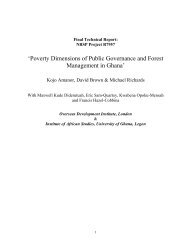The Gambian Tourist Value Chain and Prospects for Pro-Poor Tourism
The Gambian Tourist Value Chain and Prospects for Pro-Poor Tourism
The Gambian Tourist Value Chain and Prospects for Pro-Poor Tourism
You also want an ePaper? Increase the reach of your titles
YUMPU automatically turns print PDFs into web optimized ePapers that Google loves.
<strong>Tourism</strong> in <strong>The</strong> Gambia: International ‘Best Practice’ in Poverty Reduction & <strong>Pro</strong>-<strong>Poor</strong> Growth Through <strong>Tourism</strong><br />
Draft Report (Friday 22 nd December 2006)<br />
Table 5 provides clear evidence that <strong>The</strong> Gambia’s dependence upon the British market is<br />
not unusual – but it is also not inevitable. Generally it can be seen that Europeans travel to<br />
countries with which they have a shared history <strong>and</strong>/or language. However, some countries<br />
have broken out of this colonial pattern. For instance, note the number of Germans <strong>and</strong><br />
Italians travelling to competitor destinations <strong>for</strong> <strong>The</strong> Gambia in Cape Verde <strong>and</strong> Tunisia –<br />
where they have no particular cultural legacy.<br />
Table 5: African Inbound <strong>Tourism</strong> from Larger EU Markets, 2003<br />
Rank Country: France UK Germany Italy Spain Belgium<br />
Netherla<br />
nds<br />
Total<br />
1 Tunisia 833,989 223,189 488,481 379,773 78,223 132,596 44,490 2,180,741<br />
2 Morocco 916,147 134,059 129,391 100,001 231,156 80,062 66,486 1,657,302<br />
3 S. Africa 127,760 456,468 257,018 49,818 25,597 42,735 120,933 1,080,329<br />
4 Kenya 55,057 177,339 180,156 61,428 11,667 7,424 20,933 513,589<br />
5 Mauritius 200,229 91,210 53,970 39,774 9,081 10,170 4,403 408,837<br />
6 Senegal 181,470 3,063 7,985 9,279 12,682 0 0 214,477<br />
7 Nigeria 50,149 31,310 48,915 53,166 16,886 5,537 4,349 210,312<br />
8 Algeria 106,042 4,549 7,049 10,571 8,600 3 801 1,525 142,137<br />
9 Tanzania 22,103 43,656 19,222 24,675 9,565 6 497 15,272 140,990<br />
10 Zimbabwe 12,504 58,354 25,902 18,682 3,891 0 0 119,333<br />
11 Namibia 9,364 19,291 58,036 8,809 4,448 4 197 11,778 115,923<br />
12 Cape Verde 12,847 1,140 18,095 54,278 7,679 9 702 0 103,741<br />
13 Seychelles 25,990 18,765 15,903 17,771 2,062 1 392 978 82,868<br />
14 Zambia 4,050 64,970 5,627 3,025 0 0 0 77,672<br />
15<br />
Burkina<br />
Faso<br />
47,663 2,475 4,683 3,215 0 4 984 2,734 65,754<br />
16 Lesotho 0 39,470 25,991 0 0 0 0 65,461<br />
17 Gambia 653 40,872 4,253 200 0 1 707 7 262 54,947<br />
18 Mali 22,539 1,460 2,412 3,476 2,637 0 0 32,524<br />
19 Botswana 2,730 14,445 6,584 2,168 2,097 0 4,181 32,205<br />
20 Ug<strong>and</strong>a 3,022 17,176 3,519 1,924 0 1,748 2,474 29,863<br />
21 Ethiopia 5,482 8,976 5,719 6,348 0 1 ,70 3,044 29,571<br />
Total 2,639,790 1,452,239 1,368,911 850,192 426,269 313,922 310,427<br />
Source:<br />
Global Development Solutions (2006) <strong>Value</strong> <strong>Chain</strong> Analysis <strong>for</strong> the <strong>Tourism</strong> Sector in Ethiopia based on<br />
WTO statistics<br />
Internal factors have also contributed, such as the inability to implement the conducive<br />
enabling environment recognised in tourism policy. However, there are grounds <strong>for</strong><br />
optimism. International arrivals in <strong>The</strong> Gambia appear to be on a steep upward trajectory<br />
since 2001, with air charter arrivals increasing from 57 231 in 2001 to 110 815 in 2005<br />
(according to Gambia <strong>Tourism</strong> Authority). <strong>The</strong>se arrival statistics are important because,<br />
when compared with the 7,000 beds available (implying 2.55 million bed nights per year)<br />
they provide a broad-brush estimate of occupancy levels. 110,815 arrivals with an average<br />
length of stay of 11 nights implies a dem<strong>and</strong> of 1.22 million bed nights of accommodation –<br />
suggesting an aggregate bed occupancy figure <strong>for</strong> the year of just under 50%. However,<br />
aggregate occupancy figures can be misleading in a seasonal destination where some hotels<br />
still close down <strong>for</strong> the low season.<br />
Seasonality is an important feature of <strong>Gambian</strong> tourism <strong>and</strong> central to explaining the low<br />
aggregate occupancy figure. ‘Winter sun’ destinations focus activity into a peak season<br />
from November to April <strong>and</strong> often suffer a ‘summer hole’ in tourist dem<strong>and</strong>. Hotel<br />
managers reported average occupancy levels of 71% in the high season <strong>and</strong> 25% in the low<br />
season – implying scope to improve occupancy levels even during the six months of the high<br />
season each year.<br />
This seasonal pattern does impact on the viability of fixed assets (like hotels) in the<br />
destination trying to make a return during the low season. Seasonality also puts product<br />
owners <strong>and</strong> managers in a weak bargaining position vis-à-vis international tour operators<br />
when supply greatly exceeds dem<strong>and</strong> – as can be demonstrated empirically by comparing<br />
room rates in the low <strong>and</strong> high season.<br />
22

















